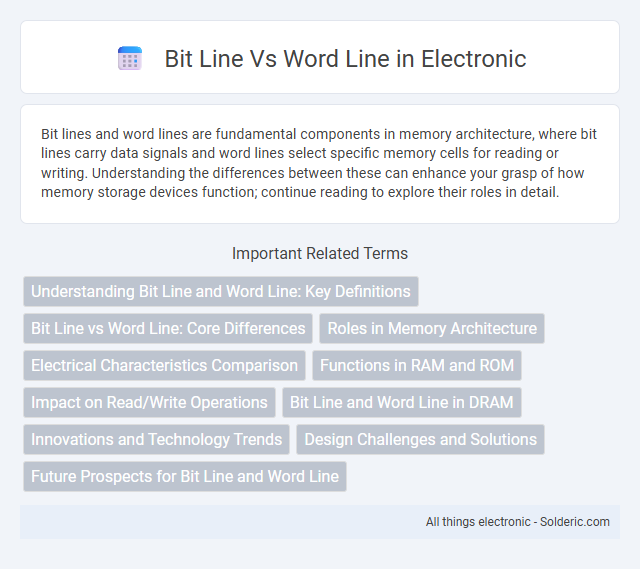Bit lines and word lines are fundamental components in memory architecture, where bit lines carry data signals and word lines select specific memory cells for reading or writing. Understanding the differences between these can enhance your grasp of how memory storage devices function; continue reading to explore their roles in detail.
Comparison Table
| Feature | Bit Line | Word Line |
|---|---|---|
| Function | Transfers data bits to/from memory cells | Selects memory rows for reading or writing |
| Orientation | Vertical lines in memory array | Horizontal lines in memory array |
| Role in RAM | Carries data signals during read/write operations | Activates a row of memory cells |
| Control | Driven by sense amplifiers | Driven by row decoders |
| Signal Type | Data signals (bit values 0 or 1) | Address signals (select line) |
| Importance | Essential for data retrieval and storage | Essential for addressing memory locations |
Understanding Bit Line and Word Line: Key Definitions
Bit lines serve as data carriers in memory arrays, transmitting binary information to and from memory cells during read and write operations. Word lines function as control signals, activating specific rows of memory cells by enabling access to their stored data. Differentiating their roles is essential for optimizing memory architecture and improving data access efficiency in semiconductor devices.
Bit Line vs Word Line: Core Differences
Bit Line and Word Line serve distinct roles in memory architecture; Bit Lines carry data signals to and from memory cells, while Word Lines activate specific rows within the memory array for reading or writing. The Bit Line aligns vertically and interfaces with memory cell columns; Word Line runs horizontally, selecting entire rows to control access to multiple bits at once. Understanding your memory's Bit Line vs Word Line dynamics helps optimize data storage and retrieval efficiency in devices such as DRAM and SRAM.
Roles in Memory Architecture
Bit lines serve as the data transmission pathways, carrying charge states that represent stored bits to and from memory cells during read and write operations. Word lines activate specific rows of memory cells by applying voltage, enabling access to the selected cells for data retrieval or storage. Understanding the distinct roles of bit lines and word lines is essential for optimizing your memory architecture's efficiency and performance.
Electrical Characteristics Comparison
Bit lines exhibit higher capacitance and resistance due to their longer physical length and connection to multiple memory cells, impacting signal integrity and read/write speed. Word lines typically have lower resistance but can suffer from increased parasitic capacitance as they activate multiple cells simultaneously, influencing access time. Understanding the electrical characteristics of bit lines versus word lines is crucial for optimizing your memory circuit performance, especially in dynamic random-access memory (DRAM) designs.
Functions in RAM and ROM
Bit lines serve as data pathways in RAM and ROM, facilitating the reading and writing of individual bits by connecting memory cells to sense amplifiers or output buffers. Word lines activate entire rows of memory cells simultaneously, enabling access or modification of stored data in the selected row. Both components are crucial for the organized addressing and retrieval processes within semiconductor memories, optimizing speed and efficiency in data storage operations.
Impact on Read/Write Operations
Bit lines and word lines critically influence read/write operations in memory arrays by controlling data access and storage. Bit lines serve as data carriers for reading and writing bits to memory cells, while word lines activate specific rows for access, directly impacting operation speed and reliability. Efficient coordination between bit line voltage sensing and word line selection reduces latency and power consumption during read/write cycles.
Bit Line and Word Line in DRAM
Bit lines in DRAM serve as the column lines that transfer data to and from the memory cells, acting as the primary data paths during read and write operations. Word lines control the row selection by activating the memory cells within a specific row, enabling access to the stored charge in each capacitor. Understanding the interaction between bit lines and word lines is crucial for optimizing DRAM performance and ensuring accurate data retrieval in your memory applications.
Innovations and Technology Trends
Bit line and word line technologies have advanced through innovations like multi-level cell (MLC) architectures and 3D NAND stacking, significantly increasing memory density and speed. Emerging trends include reducing power consumption via selective bit line activation and enhancing error correction with adaptive word line control. Your memory system can benefit from these technologies by achieving faster access times and improved data reliability in modern semiconductor devices.
Design Challenges and Solutions
Bit line and word line design challenges arise from signal interference, parasitic capacitance, and noise, causing data integrity issues in memory arrays. To mitigate these, designers implement shielding techniques, optimized line spacing, and advanced materials to reduce coupling effects and improve signal clarity. Adaptive voltage control and error correction algorithms further enhance reliability in high-density memory architectures.
Future Prospects for Bit Line and Word Line
Future prospects for bit line and word line technologies are centered on enhancing memory device efficiency and scalability in semiconductor industries. Innovations in materials and circuit design aim to reduce resistance and capacitance in bit lines, improving read and write speeds, while advancements in word line architecture focus on increasing signal integrity and reducing power consumption during memory addressing. Your investment in understanding these developments can provide a competitive edge in designing next-generation memory arrays with improved performance and reliability.
Bit Line vs Word Line Infographic

 solderic.com
solderic.com